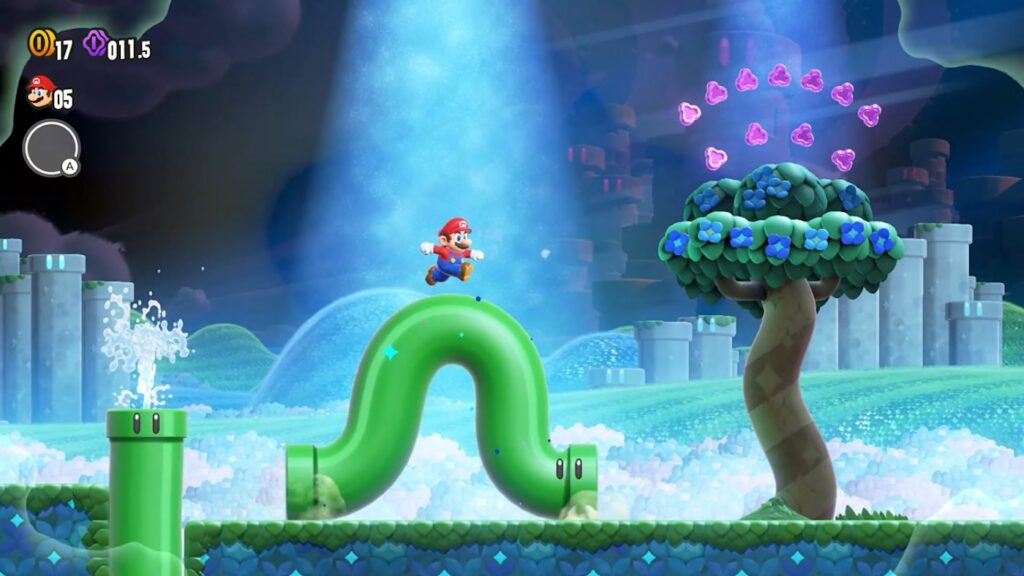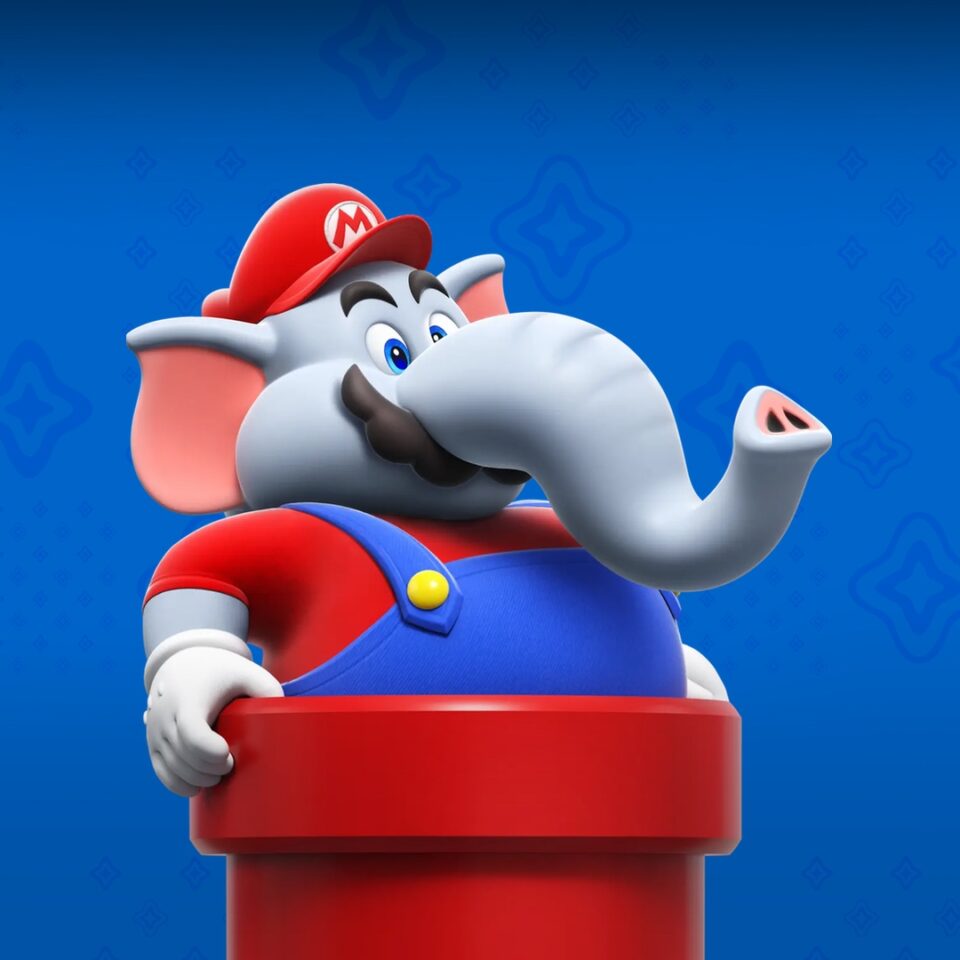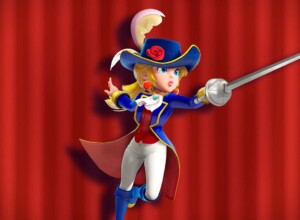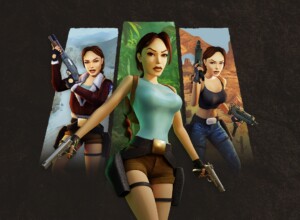The chance to see Mario change into an elephant shouldn’t be missed.
He has taken on many forms over the years, but something about this latest transmogrification, in Super Mario Bros. Wonder, simply feels right. Look at him, all lumber and stamp, the clay-grey bulk done up in dungarees, the moustache intact beneath a proud new trunk. Like all his best metamorphoses, it’s stylish, useful, and faintly fitting. Just as Cat Mario, from Super Mario 3D World, coughed up an impeccable vision of golden fuzz and allowed us to clamber across walls, so, too, did it tap into the shared traits of both hero and feline: the numerous lives, the abundant whiskers, and the will to land on one’s feet. And here comes Elephant Mario, spraying water, whipping Goombas with his newdangled schnozz – never forgetting to surprise us.
Surprise is, you might think, an unlikely currency to trade in for a developer as old and established as Nintendo. But it’s almost funny, with the release of a new Mario platformer, how predictable it is that the company will find a way to weed out your expectations and plant down fresh ideas. “Oh look, another Mario game,” you find yourself saying witheringly; and then, after minutes with it, an unshakeable smile blooms on your face. When New Super Mario Bros. came out, on the Nintendo DS, in 2006, it sounded like a joke. The pipes were in place, the princess had been swiped, and the skies were buzzed by brightly shelled villains – what was so new about it, other than the fact that you could fold it away and pull it open, ripe and unrumpled, at a moment’s notice?

The answer then had less to do with Mario’s latest power – to inflate to jumbo size and flatten all in his path – than it did with precision and style. It was tuned to the ways you felt about its forebears, and though it came with a raft of mechanical innovations, they seemed to matter less than the overall product. Nintendo had touched on the vistas of the NES and the SNES, importing the hills, the bricks, the little billows of cartoon cloud, and had combed and tightened this furniture into an untrodden space. Beneath it all ran the reassuring constants: the calibrated challenge, the near-kinaesthetic sense of control, the perfected trajectory of the jump. It was what you had always known, and you had to get to know it again. It was Mario, and it was New.
Super Mario Bros. Wonder courts a different prize, that of its title. “I remember feeling that it was full of hidden surprises and wonders … Back then, everything was new and packed with unexpected delights.” So said the game’s director, Shiro Mouri, describing the first Super Mario Bros., from 1985 – though it almost sounds like Proust. How the hell do you recapture that, after almost forty years? The answer, apparently, is a blizzard of sticky notes: over two thousand of them, glazing the walls at Nintendo headquarters, with developers of all disciplines encouraged to pitch in with ideas of their own, however brief. The resulting agglomeration was then sifted through, panned for promising glints, and given shape. The effect of this approach is that each level is pierced by an idea. What if Mario’s enemies jumped when he did? What if Mario throttled upwards through cascades like a salmon? What if Mario was cake?

That last one is less than a revelation, to be sure. He is precisely as you would imagine – clumsy, creamily immobile, red, and miraculously self-raising, able to hop over low obstacles. The texture of the game, then, is akin to those walls of Post-it notes; some ideas are vital reminders of what is possible, and fix themselves to the memory, while others can happily be scrunched and peeled from it. You wouldn’t call it disposable, but there is a scattered wackiness to Super Mario Bros. Wonder, bordering dangerously on the kooky. One level, entitled “Piranha Plants on Parade,” features just that: rows of the carnivorous flora breaking into synchronised song. It made me smirk, and it brought to mind the ingenious LocoRoco, with its dollops of dumb yellow, choiring along as they were tipped through worlds of impatient colour.
That game, made by Japan Studio, moved with a kind of focussed madness. The squiggles, the monsters, the patterned prints: it was a collage of noise that cohered around the theme of incoherence, encapsulated nowhere better than in the sight of its multiple heroes merging into a single, smiling blob. It isn’t that Super Mario Bros. Wonder flounders for want of a theme, more that you sense a developer of unreachable powers striving to delight us – strained, here and there, with the effort. The levels are bound by a plot, not the narrative but rather earthy kind. The Flower Kingdom is the setting, and it sees Mario and his entourage tilling back and forth over its seven hubs in search of Wonder Seeds. These are good for stopping Bowser, but more important are the Wonder Flowers. There is one in almost every level, tucked out of sight; once collected, the established rules liquesce into surges of wild fancy.

Green pipes make like worms. Mario starts walking on the backgrounds. A stampede of buffalo bears you along, trampling the flagpole that traditionally marks a level’s end. The latter is more irreverent as an image than it is as a mechanic; the rituals of old are at full-mast here, fluttered by breezy riffs and spins, energised by restless invention. This is no bad thing. There are those who hold that 2-D Mario outings are lesser than their 3-D siblings, as though Mario’s power to stir us were fundamentally pressed, by the lack of depth, into crisp and airless spectacles of pure design. There may be something in that, but Super Mario Bros. Wonder – the first purely side-scrolling Mario in eleven years – is filled with the kind of depth that matters. It’s the work of masters, and there are moments of unfiltered communication between them and you where you can’t help but laugh. Nintendo is always fervently courteous and respectful of time: yours, their own, and that which enfolds us. This may not quite achieve wonder, but no matter. It is Mario, and it is new.

Game: Super Mario Bros. Wonder
Platform: Nintendo Switch
Developer: Nintendo
Publisher: Nintendo
Release Date: Out Now






